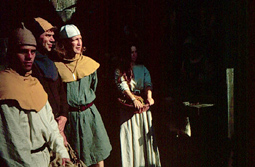Meet the Middle Ages
BackWho owned the farm?

The peasant did not always own the farm where he lived with his family. A nobleman, the Church, a monastery or the Crown could just as well own it. In Sweden and Norway, about half of the peasants owned their farms, while in Denmark only a tenth of the peasants were freeholders. In the eastern part of Sweden (present-day Finland), most peasants owned their farms.
Those who owned their farms, the free-holders, paid tax to the King. Those who leased it, the tenant farmers, paid a fee to the landowner. The tenant farmer had a contract which normally lasted for six years. The landlord and the tenant then negotiated new terms, for example whether the peasant could stay on, and what the fee would be. The tenant farmer also had to do labour service on the landowner’s farm. He had to help with the hay-making and harvest. It could be difficult for the tenant when the Bailiff of the nobleman or monastery came on horse to collect the rent or to tell him what work he had to do for his landlord.
The farms within one village could have different owners. Everybody had to pay his tithes to the Church. However, the difference between the taxes paid to the King, or the fees paid to the landowner could be very large In times when many farms where deserted ,for example after the Black Death, the farms could be rented cheaply. In other times, the fee was very high and the peasant had to do many days of heavy labour-service for the landlord.
To the peasant, it did not matter very much who was the owner of the land he farmed.
You can read more about different kind of peasants under "Society".